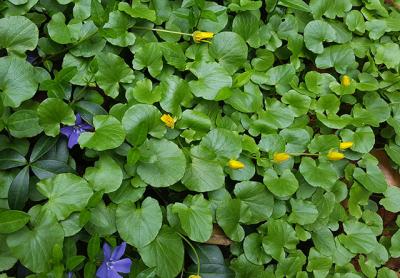Nature Notes: Like Clockwork

Driving along a wood-edge road recently, you may have noticed a small tree, almost leafless but with many white quarter-size flowers. The smooth shad is in bloom. It's not as common as its sibling species, Canada shad or shadblow, which blooms a week or so later and is common in sandy habitats such as those along the Napeague stretch. As with most of our deciduous trees, the flowers precede the leaves.
Three weeks ago when I pulled into the driveway of my house in Noyac I noticed that violet periwinkle flowers carpeted much of the front yard, while only a day or two earlier only a few could be seen. On April 23 I looked out my bedroom window and saw the first lesser celandine in bloom. Two days later on a trip to Riverhead, a side road there was covered with their bright yellow blooms. I reckoned that the ones in my yard and the Riverhead ones bloomed at about the same time. Celandines are buttercups, and buttercups, whether native or Eurasian, bloom in early spring as a rule.
The clockwork precision with which certain flowering plants burst into bloom is one of the great mysteries of the natural world. Whether spring is cold and somewhat snowy, as this year’s was, or warm and dry like some of those in the past, certain flower species bloom at about the same time year in and year out. Obviously, day length, also known as photoperiod, has something to do with this phenomenon, but so does a plant’s genetic makeup.
The same goes for the leafing out of hardwood trees. Of our common ones, maples, in particular the red maple, are the first to flower and leaf out. Norway maples, along with the smooth shad, are next in line. The oaks should be along soon, especially those in the black oak group, such as our common black and scarlet oaks.
Occasionally, the weather is so different that trees, shrubs, and wildflowers bloom out of season. For example, some forsythia bushes started blooming in last year’s warm December. I wondered if those same forsythia bushes would bloom again come early spring, when their yellow flowers usually pop out. They did!
Which came first, the chicken or the egg? Did the robins, blackbirds, ospreys, piping plovers attune their returns to the first signs of spring, namely the greening of grasses, the flowering of white flowers in the cabbage family, the little piles of digested dirt covering a grassy sward that point to active earthworms?
Henry David Thoreau kept track of the coming and going of plants while living next to Walden Pond. Before him, John James Audubon painted every single bird that came his way. Primitive people without calendars kept track of the comings and going of the seasons using similar clues. For centuries farmers and fishermen have relied on such signs to guide their efforts throughout each year.
By now we know that wildlife, too, keep track of the seasons, especially outside the tropics, where the seasons are very well demarcated. Migrations of birds, fish, marine mammals, and some terrestrial mammals, like caribou, are dependent upon knowing the signs of the seasons.
As we move further and further into the postindustrial era, and simultaneously become more and more intrigued with and dependent on artificial intelligence, we find ourselves in a mishmash state, warring with one another, over-indulging, moving passively along to the tune of societal pressures, which come and go and ceaselessly change almost as if overnight. The truth is, we are seriously out of whack, and unless we stop and not only smell the roses but count them as well, we and society will become wackier and wackier and ultimately pass out of existence.
Look and listen to the birds and plants in your yard. Each year they appear, either fly in, pop up, or leaf out. They do this effortlessly and without the help of glyphosate and industrialized fertilizers. Each year without exception, the birds in the yard and elsewhere, pair up, build nests, lay eggs, raise young and fledge them, seemingly effortlessly. If ever they should try to change their basic living habitats, it would spell doom. Sure, they adjust to our fancies, take our nuts and grains when it’s cold and convenient, drink from, and bathe in our birdbaths, but they never lose track of their primary being, their number-one way of sustaining themselves, which is written indelibly into their very DNA.
We can learn more from them than they can learn from us.
Larry Penny can be reached via email at [email protected].
